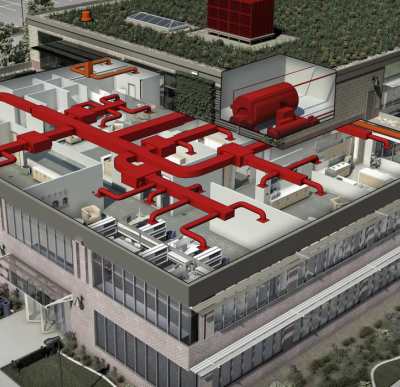Large windows provide light to spaces along the exterior walls of the building, but daylight can be best used when complementary technologies are employed, for example lighting controls that can automatically turn off overhead lighting when daylighting is sufficient. Dimmers designed specifically for fluorescent or LED lighting can also be incorporated into this control scheme, providing a gradual transition between natural and artificial light throughout the day. Light shelves can help reflect light to the interior of the space, making the best use of a window’s area. Exterior shading or overhangs can let more light in the space during the winter, when heat from the sun is needed, and block higher-angled light in the summer, decreasing cooling loads. Window coatings also have an impact on the amount and color of light entering your building. Occupants seated near windows may experience glare on computer monitors and be tempted to close blinds, cutting off daylight to those in the interior of the building. Provide these employees with glare-reducing filters for computer monitors so that use of blinds is reduced.
System Bundling
When considering an IEQ focused renovation project of any size, consider bundling components together to create strategies that deliver the largest beneficial impacts and greatest return on investment. Often these components span building-wide systems as IEQ is ingrained in all the building systems and impacts all aspects of human comfort and health. The system bundling section can be leveraged to further understand whole building synergies and explore examples for ideas on what technologies might best be bundled together.
Solid Waste and Indoor Environmental Quality (IEQ)
If used inside, ensure that solid waste compactors are supplied with an adequate amount of fresh outside air and vented directly to the outside and not recirculated within the building’s HVAC system. All equipment used for the management of solid wastes must be cleaned and maintained on a quarterly basis at a minimum to ensure smooth operation of ongoing waste management services for the building. Special care must be taken with outdoor installations to reduce/eliminate pests and unauthorized usage by non-building management personnel. Odors of any sort (i.e., cleaning solvents or air fresheners) may provide an unpleasant odor that may cause headache or nausea by property occupants. To decrease unwanted pests and control odors, food waste collection for offsite composting needs to be in properly contained, well-ventilated areas, and regularly picked up for disposal.
Low Upfront Cost IEQ Renovation
Green Cleaning and IEQ Management Plans require more organization restructuring than a large financial cost upfront. Optimizing the effectiveness of the custodial staff, who represent up to 80 percent of the total maintenance cost over the lifecycle of the building, will greatly offset any price premiums associated with non-hazardous cleaners and equipment. Preventative maintenance, through pollution source control measures such as entryway dirt capture systems and high-MERV rated filters, ensure ongoing maintenance costs are mitigated while only requiring a low upfront investment.
Optimize Indoor Air Quality and Energy Efficiency
The quality of air that we breathe should be a concern for everyone within the building. Luckily there are simple measure that can be taken to ensure this air is free of harmful airborne contaminants, such as volatile organic compounds (VOCs), mold spores, and particulate matter.
- First, control pollutant sources: integration of low-emitting materials and entryway dirt capture systems with a comprehensive Green Cleaning, IPM, and IEQ maintenance plan will help prevent IAQ contaminants from being introduced to the space.
- Second, dilute IAQ pollutants with fresh air ventilation. While increasing the ventilation rates of the HVAC system is the easiest way to replenish indoor air, it can use additional energy. Install CO2 sensors at strategic locations and tie these to fan controls to ensure that that adequate ventilation is available based on space occupancy and use, but only when needed (Also known as Demand Control Ventilation). Natural ventilation approaches can also help achieve good indoor air quality while minimizing additional energy use. Optimizing both IAQ and energy efficiency involves cognizant management of HVAC and IEQ sources.
Renovating or retrofitting a workspace also provides the opportunity to give special consideration wall materials and surface treatments, air/moisture barriers, and ceiling material to control these contaminants. Integration of low-emitting materials and entryway dirt capture systems with a comprehensive Green Cleaning and IEQ maintenance plan will help prevent IAQ contaminants from being introduced to the space.
Optimize Occupant Comfort
Optimizing comfort leads to happier occupants, every day of the week. The simplest way to improve occupant comfort is to provide occupants with as much control over environmental conditions as possible. This controllability allows occupants to adjust their surroundings or seek out spaces conducive to their working patterns and personal comfort levels. Thermal zones and individual lighting controls allow workers to alter their thermal and lighting environment respectfully. Consider using natural daylight augmented with photosensors to create an effective and properly illuminant indoor lighting strategy. Providing mobility, through wireless internet connections and mobile laptops, gives even greater flexibility. Even operable windows allow occupants to alter ambient ventilation and can contribute to an overall satisfying and comfortable space.





